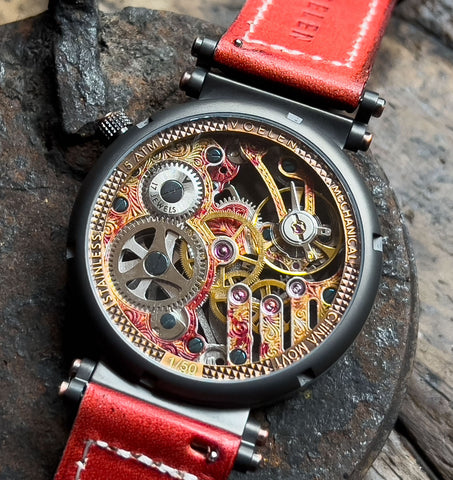Are you wondering how to tell if your watch is mechanical? The answer can be quite straightforward. It’s in the watch movements. And when we talk about watch movements, we're referring to the engine that powers the watch.
There are two main types of movements to know: quartz and mechanical. A quartz watch requires a battery as its primary power source, while a mechanical watch harnesses energy from a wound spring.
Additionally, within mechanical watches, we find two sub-categories: manual (hand-wound) and automatic (self-winding).
Mechanical watches are akin to the intricate workings of a VOELEN Watch, where precision craftsmanship is paramount. The charm of a mechanical watch comes from its complex assembly of gears and springs working harmoniously without the need for a battery.
It's the kind of watch that is often treasured and passed down through generations.
Identifying Mechanical Watches
Before we delve into the details, remember that identifying a mechanical watch involves analyzing its movement type. This helps in understanding the subtleties that differentiate it from a quartz watch.
Understanding Watch Movements
A watch movement, or caliber, is known as the heart of a watch, and it's what makes it tick - quite literally. In mechanical watches, the movement is powered by a tightly wound spring. This spring releases energy through a series of gears and components, including the balance wheel.
This intricate symphony of parts works together to keep time. Unlike quartz watches, which require a battery, a mechanical watch's energy comes from its winding mechanism.
Observing the Sweep of the Seconds Hand
The simplest way to distinguish between a mechanical and quartz watch is by observing the movement of the hands.
On a mechanical watch, you'll see the second hand sweeping smoothly around the dial. In contrast, the second hand on a quartz watch tends to tick once every second. This ticking movement happens in a jumpier fashion due to the battery-powered movement.
Mechanical watches often boast the beauty of this smooth motion, a detail that can captivate us as we watch time pass by.
The Role of the Crown and Winding
The crown of the watch—the little knob on the side of most timepieces—plays a critical role in the functionality of mechanical watches. By winding the crown, you are essentially winding the main spring. This winding provides the mechanical watch with the energy it needs to run.
In automatic mechanical watches, a rotor that moves with the wrist's motion does the winding. The absence of a battery and the presence of a rotor or manual winding is a tell-tale sign you're dealing with a true piece of mechanical art.
In our mechanical collection at VOELEN, we cherish the timeless elegance of mechanical movements. There’s a tactile pleasure in winding the crown of your watch. Observing the second hand sweep gracefully across the timepiece is an experience we seek to provide to enthusiasts and new owners alike.
With every VOELEN timepiece, the heritage of traditional watchmaking is right on your wrist, ready to be a part of your daily journey.
Features of Mechanical Watches
Three significant features stand out when we consider mechanical watches' remarkable intricacies. The type of movement, the escapement mechanism, and the power reserve indicators are essential markers of their craftsmanship.
Automatic and Manual Movements
The distinction between automatic and manual mechanical watches is in how the mainspring is wound.
An automatic movement harnesses the energy from the motion of our wrist to wind the mainspring, eliminating the need for daily hand-winding. In contrast, manual movements require a more direct connection between us and our timepiece as we perform the winding ritual to keep it ticking.

The Beauty of the Escapement
At the heart of a mechanical watch lies the escapement, a complex component that releases the energy from the mainspring in controlled increments. It's responsible for the watch's accuracy. Often visible through a see-through case back, the escapement showcases the oscillation of the balance wheel and the rhythmic dance of the gears. This fascinating ballet of precision parts, including the hairspring and the lever, is not just about function. It also adds to the aesthetic pleasure of owning a mechanical timepiece.
Power Reserve Indicators
The power reserve indicator is the mechanism by which a watch keeps track of remaining energy. It's an especially handy complication on manual watches, reminding us to wind the watch before it stops.
For those wearing an automatic watch, this feature offers a glimpse into the watch's self-sufficiency. Emphasizing how it draws energy from our movement by displaying the amount of stored power.
